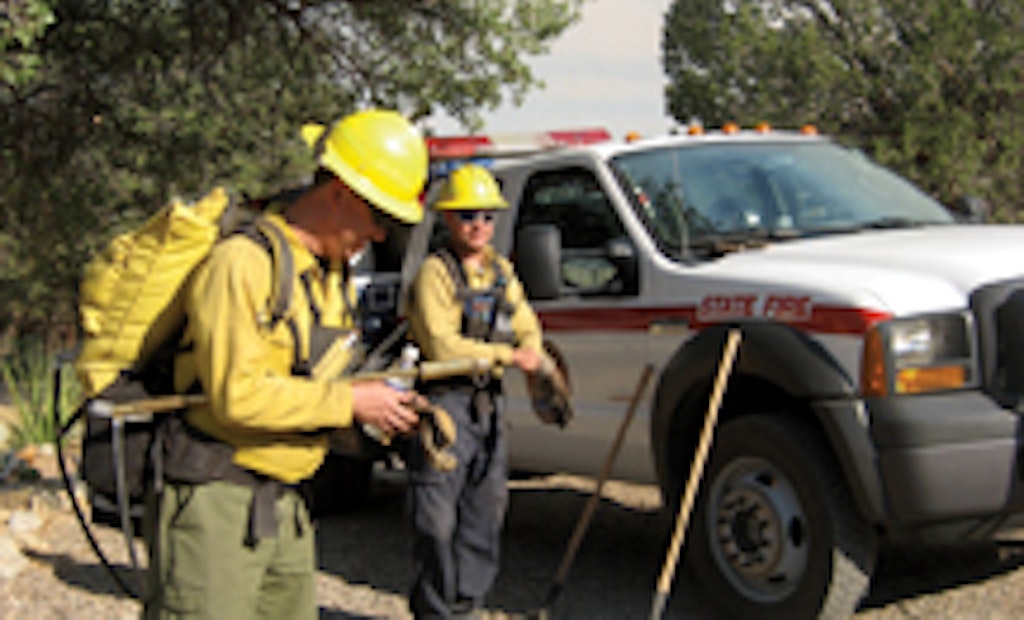
Interested in Stormwater?
Get Stormwater articles, news and videos right in your inbox! Sign up now.
Stormwater + Get AlertsWildfires are becoming a bigger problem every year. As cities and townships expand into heavily forested areas, utilities need to consider the risk of wildfires and fires’ impacts on drinking water systems and watersheds.
According to “Wildfire Today,” 2012 saw the third-highest number of burned acreage on record, greater than nine million. Firefighting resources and mitigation strategies are improving, but the sheer number and intensity of wildfires continue to threaten the nation’s water systems and ultimately water quality.
Pick your battles
Containing and extinguishing forest fires is only the first battle in the war against nature’s fury. Communities are left with the enormous task of rebuilding. Clean water availability is critical, and restoring water infrastructure becomes an urgent priority.
Drinking water plant operators are front and center to quickly overcome a range of logistical treatment obstacles in the wake of wildfires. The best way for municipalities to confront these challenges is to be proactive: Ensure all staff members are knowledgeable about necessary steps to protect watersheds affected by wildfires, and regularly review preventive measures in other at-risk communities to reduce the negative impacts of future disasters.
Water quality is almost always impaired after a wildfire. Pollutants produced by the fire, chemicals used in suppression, and an influx of debris such as fine ash, soot, and rock particles entering watersheds affect drinking water facilities.
“The main issue is debris,” says Zeke Campbell, water quality and environmental compliance manager for Denver Water. “Utilities have to encounter this first.”
After a fire the vegetation that plays a critical role in erosion prevention is gone. Without vegetation, precipitation does not slow down and hydrophobic soils prevent ground saturation.
Stormwater runoff can quickly result in downstream flooding, which causes sewer backups. Municipal workers need to be aware of the necessary safety precautions for working in areas where a sewer has backed up. Floodwater also can disrupt water purification and sewage systems and sweep up toxic waste, chemicals and other contaminants previously stored above ground.
Contaminated water mixes with sediment and gushes into surface water, and lakes and reservoirs become overwhelmed with sediment and debris.

Step-by-step process
“The treatment folks are going to do what they do best,” Campbell explains. He offers a step-by-step process that Denver Water workers implement after a wildfire:
- Assess the burn area
- Place turbidity monitors in key areas and dispatch staff to the field for on-site reporting as needed
- Set up sediment traps
- Add more coagulants to the coagulation/flocculation basin as the debris-saturated water enters the plant
- Add disinfectants
- Filter
- Add more disinfectants
Campbell says that after one recent fire, plant operators were able to produce potable water, but could not eliminate a distinctive smoky aftertaste. It was harmless, but that didn’t keep concerned users from flooding his office with phone calls.
Kim Gortz, water protection project manager at Colorado Springs Utilities, has seen similar situations. “When fires have gone through an area, you have watersheds that are devoid of vegetation,” she says. “The landscape is exposed to erosion impacts and flooding.”
The first step is assessing the damage from a variety of perspectives. “A ‘Burn Team Area Response’ consists of hydrologists, biologists, soil specialists and resource managers,” Gortz continues. “They assess the burn severity and decide where they’re going to put some emergency treatment.” That process involves heavily mulching areas where rain events will produce dangerously high levels of runoff and monitoring them closely.
Gortz recalls last year’s Waldo Canyon fire as a prime example. The fire was extinguished on June 30; it wasn’t until 30 days later that two inches of rain caused destructive floods. Several drainages were affected by sand and gravel. Clogging resulted in the scouring of roads. Large boulders the size of cars rolled onto the pipelines.
Culverts were overwhelmed with runoff and became ineffective. “It took us pretty much a whole year to restore some of the watershed areas and fix infrastructure,” she says. Her team worked strategically to mulch high-risk areas as quickly as possible, which prevented further devastation. But as with most communities affected by wildfires, the vast burn areas force responders to pick and choose which areas to mulch and in what order. Gortz believes that more should be done to prevent wildfires from affecting key watersheds in the first place.
“Get the government to free up two, three billion dollars and you might begin to scratch the problem,” says Ken Neubecker, executive director of the Western Rivers Institute, a nonprofit organization dedicated to “bringing a 19th century water system into the 21st century.”
Neubecker urges more public policy initiatives to fund and research better methods to prevent out-of-control fires from ravaging the western landscape. Thorough community planning, tactical forest thinning and management, and implementing more retention basins, for example, could at least diminish the potential threats that fires would have on the future sustainability of sound hydrological infrastructure.





